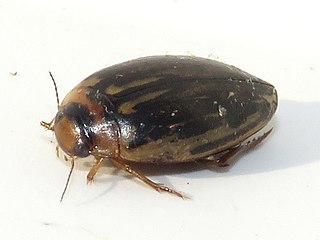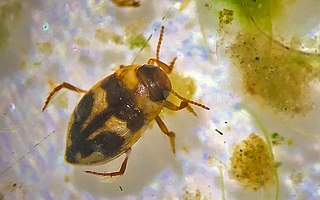
The Dytiscidae – based on the Greek dytikos (δυτικός), "able to dive" – are the predaceous diving beetles, a family of water beetles. They occur in virtually any freshwater habitat around the world, but a few species live among leaf litter. The adults of most are between 1 and 2.5 cm (0.4–1.0 in) long, though much variation is seen between species. The European Dytiscus latissimus and Brazilian Megadytes ducalis are the largest, reaching up to 4.5 cm (1.8 in) and 4.75 cm (1.9 in) respectively. In contrast, the smallest is likely the Australian Limbodessus atypicali of subterranean waters, which only is about 0.9 mm (0.035 in) long. Most are dark brown, blackish, or dark olive in color with golden highlights in some subfamilies. The larvae are commonly known as water tigers due to their voracious appetite. They have short, but sharp mandibles and immediately upon biting, they deliver digestive enzymes into prey to suck their liquefied remains. The family includes more than 4,000 described species in numerous genera.

Dytiscus latissimus is a large species of aquatic beetle in family Dytiscidae. It is native to Europe and considered threatened.

Bifurcitus ducalis, formerly Megadytes ducalis, is a species of water beetle in the family Dytiscidae. It is the largest species in the family. Until recently, the species was only known from a single specimen that was collected in the 19th century from Brazil, but more specimens, also collected in the 19th century from Brazil, were discovered in 2019. Although listed as extinct by the IUCN, the limited studies conducted on water beetles in Brazil means that it might still survive.

Megadytes is a genus of diving beetles in the family Dytiscidae. They are found in slow-moving or static freshwater habitats in the Neotropics. The adult beetles measure about 1.65–4.75 cm (0.6–1.9 in) long depending on the exact species and the largest is also the largest in the family.

Coptotomus is a genus of predaceous diving beetles in the family Dytiscidae, the only genus of the subfamily Coptotominae. There are about six described species in Coptotomus, found in North America and the Neotropics.

Hydrodytes is a genus of predaceous diving beetles in the family Dytiscidae. There are at least three described species in Hydrodytes. It is found in North America and the Neotropics.
Microhydrodytes is a genus of predaceous diving beetles in the family Dytiscidae. There is one described species in Microhydrodytes, M. elachistus. It is found in the Neotropics.
Queda is a genus of predaceous diving beetles in the family Dytiscidae. There are at least three described species in Queda, found in the Neotropics.

Cybistrini is a tribe of predaceous diving beetles in the family Dytiscidae. There are 12 genera and 130 described extant species in Cybistrini. The same set is also called Cybistrinae by authors viewing it as a subfamily of Dytiscidae.

Neoclypeodytes cinctellus is a species of predaceous diving beetle in the family Dytiscidae. It is found in North America and the Neotropics. It is a predator of the critically endangered Devils Hole pupfish and has distinctive brown patterning on its head and abdomen.
Liodessus obscurellus is a species of predaceous diving beetle in the family Dytiscidae. It is found in North America and the Neotropics.

Cybister fimbriolatus, the giant diving beetle, is a species of predaceous diving beetle in the family Dytiscidae. It is found in North America and the Neotropics.

Hydrodytinae is a subfamily of predaceous diving beetles in the family Dytiscidae. There are at least two genera and four described species in Hydrodytinae.
Fontidessus is a genus of predaceous diving beetles in the family Dytiscidae. There are about seven described species in Fontidessus. They are found in the Neotropics.
Incomptodessus is a genus of predaceous diving beetles in the family Dytiscidae. There is one described species in Incomptodessus, I. camachoi, found in the Neotropics.
Spanglerodessus is a genus of predaceous diving beetles in the family Dytiscidae. There is one described species in Spanglerodessus, S. shorti. They are found in the Neotropics.
Bifurcitus is a genus of beetles in the dytiscid subfamily Cybistrinae that occur in the Neotropics. The genus contains three species, two extant and one presumed extinct; they were previously classified in the genus Megadytes.
Paramegadytes is a genus of beetles in the dytiscid subfamily Cybistrinae that occur in the Neotropics. The genus contains two species that were previously classified in the genus Megadytes.
Trifurcitus is a genus of beetles in the dytiscid subfamily Cybistrinae that occur in the Neotropics. The genus contains six species that were previously classified in the genus Megadytes.
Nilssondytes is a genus of predaceous diving beetles in the family Dytiscidae. Following reclassification of the subfamily Cybistrinae in 2024, only a single species, N. diversus, is included in the genus.








